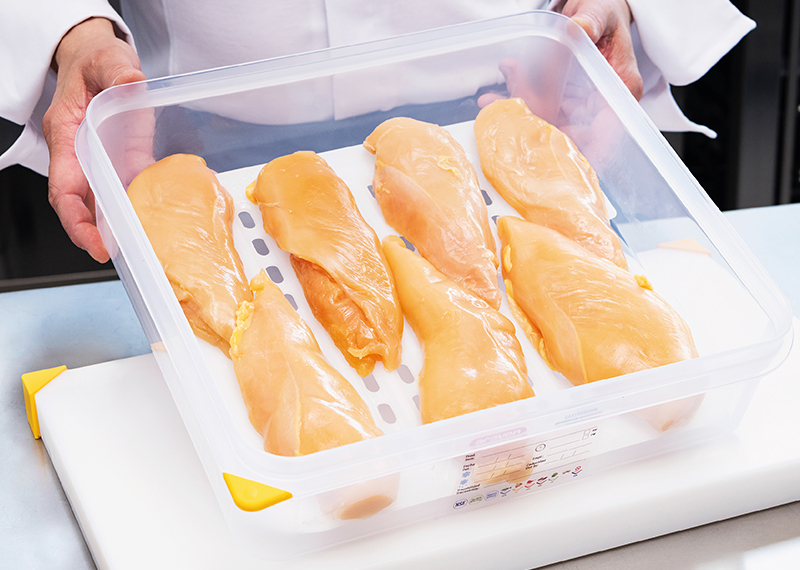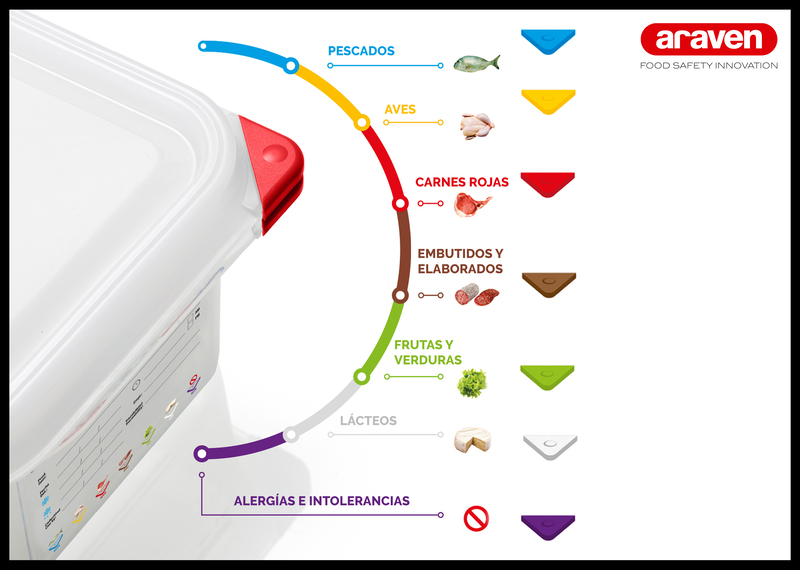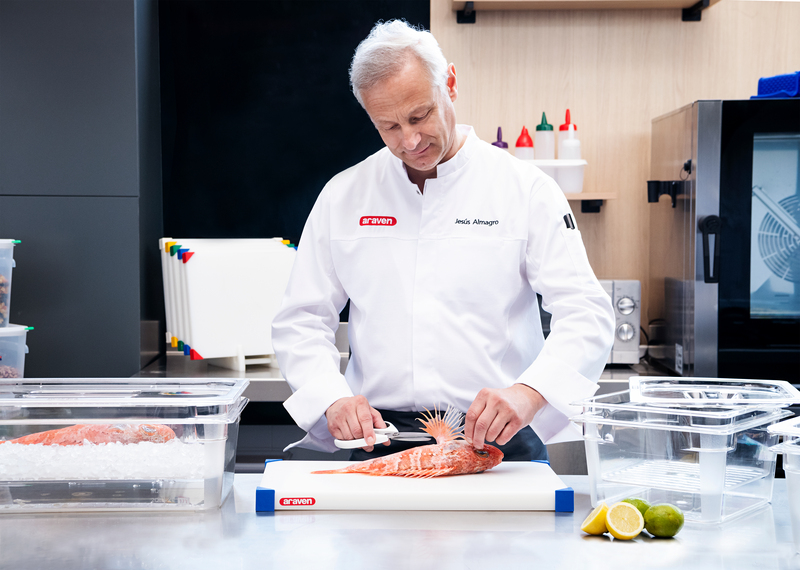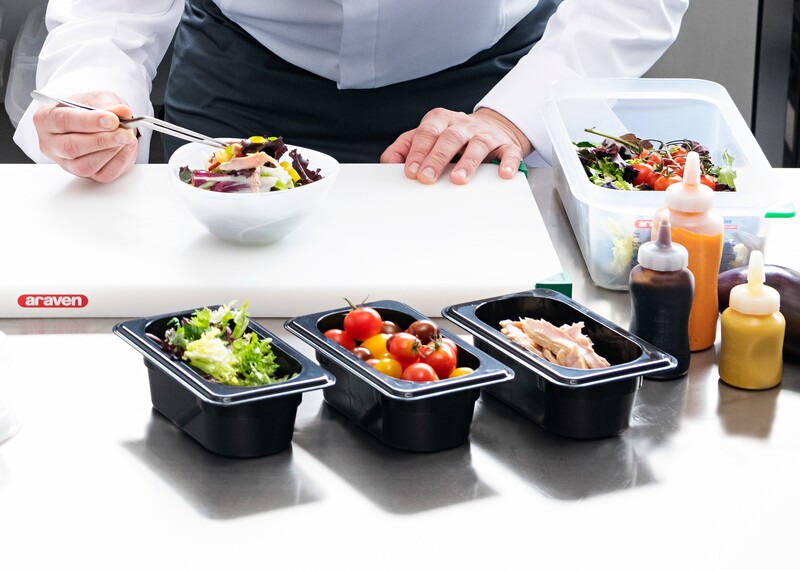Poultry meat is one of the world’s most widely consumed foods, and among the different options available, chicken is by far the most popular. Eating chicken or other poultry products is an excellent and economical way to add protein to our diet, but care must be taken when handling, thawing, storing and cooking them.
That’s because chicken can contain bacteria, such as Salmonella, which is largely responsible for serious cases of food poisoning. To prevent any health risks posed by the eating of this meat that we love so much, you need only follow a few simple tips when cooking, but also in the process of thawing frozen chicken.
Would you like to know how to safely thaw chicken and other poultry meat? We show you the best thawing and storing methods, and about the importance of separating food from its exudate, the liquid it releases when thawing.

Before we explain the best methods for thawing chicken, you need to remember the things to avoid so that the process doesn’t put your health at risk. The most important things are:
What you should avoid when thawing chicken or other poultry meat
Before we explain the best methods for thawing chicken, you need to remember the things to avoid so that the process doesn’t put your health at risk. The most important things are:
- Don’t thaw meat at room temperature: One of the most common ways of thawing chicken is to leave it out on the kitchen worktop. However, this is a mistake. When the temperature rises above 5ºC, the bacteria present in the food begin to multiply. The abrupt change in temperature between the freezer and the room outside, as well as the presence of lots of water and nutrients encourage this to happen.
- Don’t thaw in hot water: Thawing chicken in hot water is also not a good idea because it also encourages bacterial proliferation for the same reason as not thawing it at room temperature.
- Don’t put thawed chicken back in the freezer: Remember that you can only thaw food out once before cooking it. After cooking the chicken, you can freeze it again.
- Don’t wait too long to cook chicken: If you want to know how long thawed chicken will last, the answer is only one or two days in the fridge. Cooking and eating it after this time can pose a risk to your health.
- Wash your hands after handling raw chicken: Whenever you handle raw chicken, you must wash your hands once finished to eliminate any bacteria you may have picked up. You must also wash any dishes, cutlery or containers that may have come into contact with the meat.
Methods for thawing chicken
If you want to know how to safely thaw chicken, we show you the three best ways that are also risk-free
Thawing chicken in the fridge
The is the most recommended method because it allows the meat to thaw very gradually, without abrupt temperature changes or exposure to too much heat. It also requires very little effort or attention because the only thing you only have to do is leave it in the fridge.
However, thawing chicken in the fridge does require a bit of planning. You’ll need at least 12 hours for chicken breasts and at least 24 hours for larger cuts. The estimated thawing time is about 10 hours per kilogram.
Thawing chicken in the microwave
A great option if you’re short on time is to thaw chicken in the microwave. All you need to do is put the chicken into a container that can hold all the water released when thawing and selecting your microwave’s defrost setting. Although the time it takes will depend both on your microwave and the size of the cut, it typically takes about 10 minutes.
The main drawback of this method is that the meat may have areas that are thawed and others that are still frozen. If this should happen, you’ll need to repeat the process until you’re certain that it has thawed completely.
It is also advisable to cook the meat immediately after thawing it out in the microwave.
Thawing chicken in cold water
This last way of thawing chicken is quicker than using the fridge, but you’ll need to pay more attention during the process.
The first thing you have to do is put the chicken into a watertight container to prevent it from absorbing too much water and spoiling. Once you’re certain that the container is leakproof, you only need to put the container into a bowl or other recipient filled with enough cold water to cover it completely. You’ll have to change the water every 30 minutes until the chicken is fully thawed.
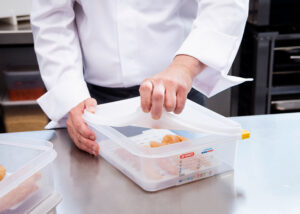
Depending on the size of the cuts, chicken can take between 1 and 3 hours to thaw out this way. And as with thawing it in the microwave, you’ll have to cook it as soon as it finishes thawing.
The importance of separating food from its exudate
The three recommended methods for properly thawing chicken provide better results in terms of both quality and safety if perforated food pans are used, as demonstrated by a study conducted by University of Zaragoza’s AgriFood Institute of Aragon (IA2).
This study, titled “Study and characterisation for the preservation of chicken meat”, concludes that the use of perforated food pans for thawing chicken reduces the presence of bacteria, increases its useful life, guarantees reduced weight loss and ensures higher quality and more juiciness when cooked
The analysis performed showed that pathogenic bacteria increased by 25% when thawing involved the use of non-perforated containers, whereas their numbers only grew by 2% when perforated food pans were used. The chicken also only lost 3% of its weight when the perforated food pan was used, while it lost 7.5% of its weight with non-perforated containers, leading to a greater loss of properties and nutrients.
The study supports the advantages of Araven perforated food pans, which allow food to be separated from the exudate it releases as it thaws. A wide selection of containers with capacities ranging from 500 ml to 70 litres can be found in our online store.
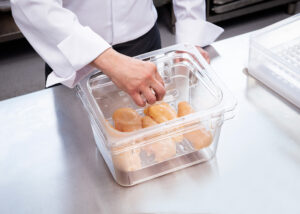
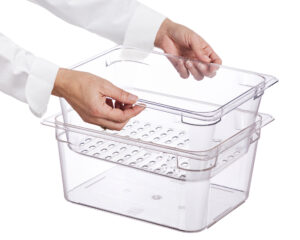
Moreover, all our products are designed for ease of use in professional settings, ensuring faster thawing and thorough cleaning.
How to store chicken correctly
In addition to thawing chicken, it is also important to know how to store this meat appropriately and safely. These are the main recommendations:
- Leave the meat out of the fridge for as little time as possible: To avoid interrupting the cold chain, chicken must be refrigerated as quickly as possible after buying it, especially in summer.
- Keep the fridge temperature at 4ºC: If you want to know the temperature for storing fresh chicken meat, the answer is no higher than 5ºC. This is why the recommended fridge temperature is about 4ºC, while your freezer should be set to -18ºC.
- Store meat in an airtight container: Because one of the most important points when it comes to storing chicken is that there should be as little contact between the air and the meat as possible, proper storage conditions are necessary to prevent contamination and early spoilage.
Freeze any excess meat: If you buy more chicken than you can consume in the next three or four days, it should be frozen using any of the recommended methods. That way you can use it up whenever you want without putting your health at risk
Now you know the best way to thaw and store chicken and other poultry meat, make sure that you have the best storage equipment. Araven offers the widest variety of food pans, airtight containers and thawing kits, among others. Visit our store and discover all our products!
